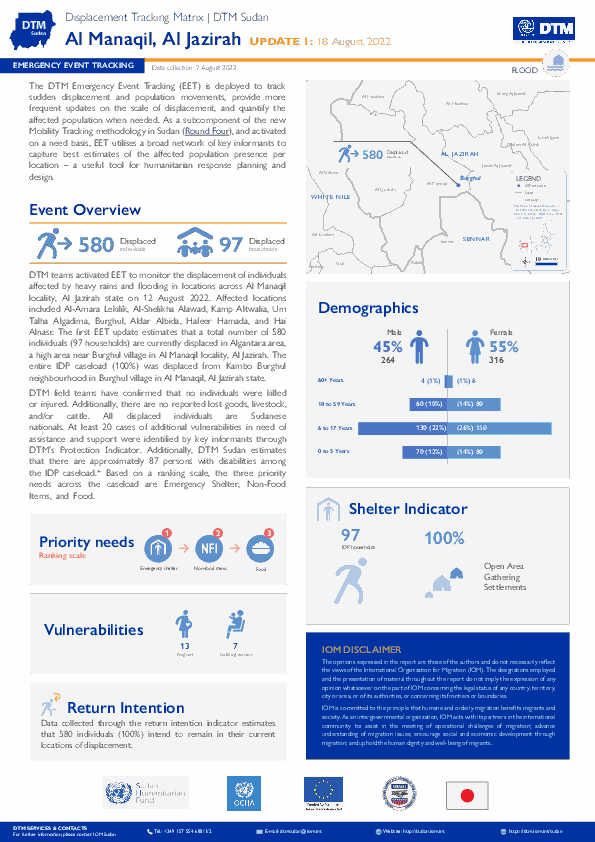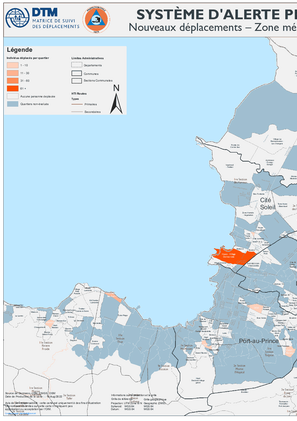-
Countries
-
Data and Analysis
-
Special Focus
-
Crisis Responses

Contact
DTM Mauritania, DTMMauritania@iom.int
Language
English
Location
Mauritania
Period Covered
Aug 01 2022
Jul 31 2022
Activity
- Survey
- Flow Monitoring Survey
- Flow Monitoring
La transhumance est une pratique de longue date en Mauritanie où elle a évolué au cours des dernières décennies avec la raréfaction des routes empruntées par les troupeaux notamment affectés par une raréfaction des ressources. Par conséquent, des conflits peuvent survenir entre les agriculteurs et les éleveurs transhumants. Dans le cadre du Suivi des Mouvements de Transhumance, l’OIM met en œuvre un système d’alerte qui a pour objectif de recenser les mouvements inattendus de bétail et les conflits ou catastrophes liés à l’utilisation des ressources naturelles et aux interactions entre agriculteurs et éleveurs, de comprendre les modes de résolution de conflits existants et d’informer les autorités compétentes, dans l’objectif de réduire et prévenir les tensions dans les régions d’intervention. Ce tableau de bord présente les informations fournies par le biais de 21 informateurs clés, présents dans huit régions (Assaba, Brakna, Gorgol, Guidimakha, Hodh El Chargui, Hodh El Gharbi, Tagant et Trarza) pendant le mois de Juillet 2022.

Contact
DTM Mali, DTMMali@iom.int
Language
French
Location
Mali
Period Covered
Jul 01 2022
Jul 31 2022
Activity
- Mobility Tracking
- Baseline Assessment
Au cours des cinq premiers mois de l’année 2022, dans un contexte marqué par l’insécurité et la fermeture des frontières terrestres et aériennes entre le Mali et les pays de la Communauté Economique des Etats de l’Afrique de l’Ouest (CEDEAO), des combats et attaques sporadiques se sont poursuivis dans plusieurs localités du pays occasionnant des déplacements internes de populations civiles dans le Nord et dans le Centre du pays. Le caractère violent des conflits a provoqué d’importants déplacements de populations à l’intérieur du territoire malien et dans les communes frontalières entre le Burkina Faso et le Niger, avec des méthodes de mouvements très complexes à suivre. Des déplacements de courte durée ont continué à être signalés dans différentes régions du pays.
Chaque semaine, de nouvelles personnes déplacées internes (PDI) continuent d’être enregistrées. Ces mouvements ont un impact considérable sur les personnes forcées de fuir leurs foyers et sur les communautés qui les accueillent.
Afin de répondre aux besoins des populations déplacées internes, rapatriées et retournées, la Commission Mouvement de Populations (CMP) recueille et analyse les informations sur les mouvements de populations à l’intérieur du Mali, afin de fournir un état complet des mouvements de populations et à la demande de ses partenaires. Les membres de la Commission sont : la Direction Générale de la Protection Civile (Ministère de la sécurité intérieur), UNHCR, OCHA, PAM, UNICEF, ACTED, NRC, DRC, HI, Solidarités International, CRS, OIM, et DNDS. Plusieurs autres entités participent régulièrement aux rencontres de la Commission.

Contact
DTM Sudan; dtmsudan@iom.int
Language
English
Location
Sudan
Snapshot Date
Aug 04 2022
Activity
- Mobility Tracking
- Event Tracking
The DTM Emergency Event Tracking (EET) is deployed to track sudden displacement and population movements, provide more frequent updates on the scale of displacement, and quantify the affected population when needed. As a subcomponent of the new Mobility Tracking methodology in Sudan (Round Four), and activated on a need basis, EET utilises a broad network of key informants to capture best estimates of the affected population presence per location – a useful tool for humanitarian response planning and design.

Contact
DTM Sudan; dtmsudan@iom.int
Language
English
Location
Sudan
Snapshot Date
Aug 07 2022
Activity
- Mobility Tracking
- Event Tracking
The DTM Emergency Event Tracking (EET) is deployed to track sudden displacement and population movements, provide more frequent updates on the scale of displacement, and quantify the affected population when needed. As a subcomponent of the new Mobility Tracking methodology in Sudan (Round Four), and activated on a need basis, EET utilises a broad network of key informants to capture best estimates of the affected population presence per location – a useful tool for humanitarian response planning and design.

Contact
iomisbdtmremapteam@iom.int
Language
English
Location
Pakistan
Period Covered
Apr 01 2022
Jun 30 2022
Activity
- Flow Monitoring
IOM Pakistan collects data on the outflows of undocumented Afghan migrants at the Torkham and Chaman border crossing points in an effort to better understand the migration movements of undocumented Afghan migrants returning to Afghanistan from Pakistan. This report is part of the European Union funded project ‘‘Displacement Tracking Matrix Regional Evidence for Migration Analysis and Policy (DTM REMAP)”. Key findings during this reporting period are:
- From April to June 2022, 17,928 undocumented Afghan migrants spontaneously returned to Afghanistan, including 2,139 through the Torkham border point and 15,789 through the Chaman border point.
- Apart from the total number of undocumented Afghan returnees, border authorities facilitated the return of 432 individuals due to the lack of legal documentation to remain in Pakistan. Therefore, information concerning these 432 individuals is not included in the report analysis.
- The average family size of returnees was 8 individuals and 12 per cent of all returnees recorded during the reporting period were categorized as vulnerable persons.
- All returnees were carrying household items, personal belongings and cash when surveyed. They also traveled with additional items, such as productive assets (94%), transportation vehicles (6%) and livestock (1%).
- The top 3 challenges returnees expected to face in Afghansitan were: arranging livelihood, settling into a new city and finding better income opportunities.
Carte des Nouvelles arrivées des PDI dans la zone métropolitaine de Port-au-Prince, du 30 juillet - 05 août 2022.
Carte des nouveaux déplacements – Zone métropolitaine de Port-au-Prince – 30 juillet - 05 août 2022.

Contact
DTM Mali, DTMMali@iom.int
Language
English
Location
Mali
Period Covered
Jul 01 2022
Jul 31 2022
Activity
- Flow Monitoring
In order to gain a better understanding of mobility flows and trends, the International Organization for Migration (IOM) has implemented the Displacement Tracking Matrix’s Flow Monitoring (FM) tool at key transit points across the region. Flow Monitoring activities are conducted in close cooperation with national and local authorities as well as local partners. The Flow Monitoring tool consists of two main components: the Flow Monitoring Registry (FMR), which captures key data on the volume, origin, destination and mode of travel of mobility flows, and the Flow Monitoring Survey (FMS), individual surveys conducted with travellers to gather detailed information about the profiles, migration experience and intentions of migrants. Through these activities, the Flow Monitoring tool collects data on migration flows and trends, traveller profiles, migration journeys, and intentions of migrants, so as to obtain a better understanding of mobility.
In Mali, DTM conducts Flow Monitoring activities at seven Flow Monitoring Points (FMPs) located across six regions, in order to foster a better understanding of the numbers, trends, profiles, and journeys of migration flows crossing these points.
This reports presents data collected through the Flow Monitoring Registry in July 2022.

Contact
DTM Mali, DTMMali@iom.int
Language
French
Location
Mali
Period Covered
Jul 01 2022
Jul 31 2022
Activity
- Flow Monitoring
Afin de mieux comprendre les mouvements et tendances migratoires, l’OIM, à travers la Matrice de suivi des déplacements (Displacement Tracking Matrix, DTM), met en œuvre l’activité de Suivi des flux de populations (Flow Monitoring, FM).
Le suivi des flux, qui est mis en œuvre en étroite collaboration avec les autorités et des partenaires nationaux et locaux, est composé de deux outils: l’enregistrement des flux (Flow Monitoring Registry, FMR), qui recueille des données clés sur l’ampleur, la provenance, la destination et les modalités des flux de mobilité, et les enquêtes individuelles (Flow Monitoring Survey, FMS), conduites auprès des voyageurs afin d’obtenir des informations sur les profils, parcours migratoires, et intentions des migrants. Le suivi des flux de populations récolte ainsi des données sur les flux et tendances migratoires, les profils des voyageurs et les parcours et intentions des migrants, afin de fournir une meilleure compréhension des mobilités.
Au Mali, la DTM recueille des données au niveau de 7 Points de suivi des flux (Flow Monitoring Points, FMP), répartis dans 6 régions afin d’obtenir une meilleure compréhension de l’ampleur, des tendances, des caractéristiques socio-démographiques et des parcours des flux de voyageurs traversant ces différents points.
Ce rapport présente les données recueillies dans le cadre des activités d’enregistrement des flux durant le mois de juillet 2022.

Contact
DTM Europe, DTMMediterranean@iom.int
Language
English
Location
Czechia
Period Covered
Jun 15 2022
Jul 29 2022
Activity
- Survey
- Flow Monitoring
Since 24 February 2022, refugees from Ukrainian and other Third Country Nationals (TCNs) have been fleeing from Ukraine to neighbouring and other EU countries as a result of the war in Ukraine. According to the Czech Ministry of Interior and Foreign Police data, 389,837 refugees from Ukraine and other TCNs registered for temporary protection in Czechia as of 29 July 2022 and 63,457 were accommodated through the KACPUs (Regional Centres for Help and Assistance to Ukraine).*
This report is based on a survey on displacement patterns, needs and intentions launched by IOM’s Displacement Tracking Matrix (DTM) in Czechia in mid-June 2022. All interviews were conducted face-to-face by IOM’s DTM trained enumerators with adult refugees and other TCNs fleeing Ukraine. This report presents an analysis based on 1,006 surveys collected between 15 June and 29 July 2022. The sample is not representative of all displaced populations from Ukraine into Czechia, and results should only be considered as indicative.
* See https://www.mvcr.cz/clanek/statistika-v-souvislosti-s-valkou-na-ukrajine-archiv.aspx

